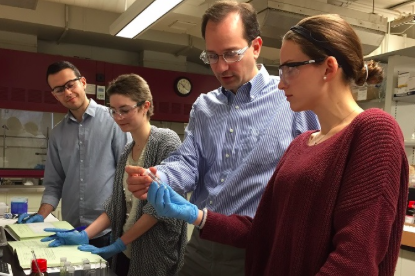
February 14, 2016
 Source/Villanova University
Source/Villanova University
Villanova University Associate Professor of Chemistry Kevin P.C. Minbiole in lab with student researchers.
A team of chemistry students at Villanova University is developing a new generation of disinfectants that can keep pace with the adaptation of super bug bacteria that have increasingly become resistant to current drugs.
Kevin P.C. Minibiole, Associate Professor of Chemistry at Villanova, organized the team of undergraduate and graduate students to find a better way to combat hospital-acquired infections – such as pneumonia, MRSA, gastroenteritis, and UTI's – that result in more than 100,000 deaths every year.
As bacteria evolve faster than new disinfectant products can reach the market, the Villanova team is experimenting with more than 300 antiseptic compounds to determine which molecular structures are most effective in attacking resistant bacterial strains.
“We’re following the Edison model of discovery,” says Minbiole. “Lots of trial and error is teaching us what compounds are the most effective and the least toxic.”
While existing sanitizers use molecules shaped like arrows to unleash quaternary ammonium compounds on bacteria cells, Minibiole's Villanova team developed a trident-like design that attacks bugs with greater potency while requiring less active ingredient. This offers the associated benefits of reducing environmental harm and cutting costs for manufacturers.
In collaboration with Temple University chemist Dr. Bill Wuest, Minibiole and his researchers have published more than a dozen studies and created a spinoff company, NovaLyse Biosolutions, to commercialize the technology. The team is also working with Villanova polymer chemist Deanna Zubris to design a surface material that incorporates the new compounds and could be used in hospitals as a defense against harmful pathogens.
Six members of the Villanova team will present their research in March at the National Meeting of the American Chemical Society.